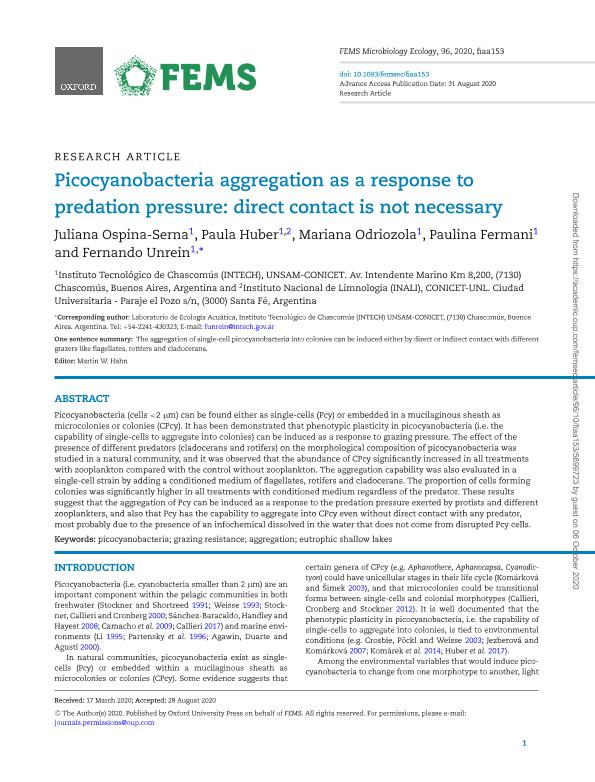Artículo
Picocyanobacteria aggregation as a response of predation pressure: The direct contact is not necessary
Ospina Serna, Juliana Andrea ; Huber, Maria Paula
; Huber, Maria Paula ; Odriozola, Mariana Paola
; Odriozola, Mariana Paola ; Fermani, Paulina
; Fermani, Paulina ; Unrein, Fernando
; Unrein, Fernando
 ; Huber, Maria Paula
; Huber, Maria Paula ; Odriozola, Mariana Paola
; Odriozola, Mariana Paola ; Fermani, Paulina
; Fermani, Paulina ; Unrein, Fernando
; Unrein, Fernando
Fecha de publicación:
08/2020
Editorial:
Wiley Blackwell Publishing, Inc
Revista:
Fems Microbiology Ecology
ISSN:
0168-6496
e-ISSN:
1574-6941
Idioma:
Inglés
Tipo de recurso:
Artículo publicado
Clasificación temática:
Resumen
Picocyanobacteria (cells <2 µm) can be found either as single-cells (Pcy) or embedded in a mucilaginous sheath as microcolonies or colonies (CPcy). It has been demonstrated that phenotypic plasticity in picocyanobacteria (i.e. the capability of single-cells to aggregate into colonies) can be induced as a response to grazing pressure. The effect of the direct contact of different predators (cladocerans and rot2ifers) over the morphological composition of picocyanobacteria were studied in a natural community, and it was observed that the abundance of CPcy significantly increased in all treatments with zooplankton respect to the control. The aggregation capability was also evaluated in a single-32 cell strain, by adding conditioned medium of flagellates, rotifers and cladocerans. The proportion of cells forming colonies was significantly higher in all treatments with conditioned medium regardless the predator. These results suggest that the aggregation of Pcy can be induce as a response of the predation pressure exerted by protists and different zooplankters, and also that Pcy has the capability to aggregate into CPcy even without a direct contact with any predator, most probably due to the presence of an infochemical dissolved into the water that would not came from disrupted Pcy cells.
Palabras clave:
PICOCYANOBACTERIA
,
GRAZING RESISTANCE
,
AGGREGATOIN
,
EUTROPHIC SHALLOW LAKE
Archivos asociados
Licencia
Identificadores
Colecciones
Articulos(CCT - LA PLATA)
Articulos de CTRO.CIENTIFICO TECNOL.CONICET - LA PLATA
Articulos de CTRO.CIENTIFICO TECNOL.CONICET - LA PLATA
Articulos(IIB-INTECH)
Articulos de INST.DE INVEST.BIOTECNOLOGICAS - INSTITUTO TECNOLOGICO CHASCOMUS
Articulos de INST.DE INVEST.BIOTECNOLOGICAS - INSTITUTO TECNOLOGICO CHASCOMUS
Articulos(INALI)
Articulos de INST.NAC.DE LIMNOLOGIA (I)
Articulos de INST.NAC.DE LIMNOLOGIA (I)
Citación
Ospina Serna, Juliana Andrea; Huber, Maria Paula; Odriozola, Mariana Paola; Fermani, Paulina; Unrein, Fernando; Picocyanobacteria aggregation as a response of predation pressure: The direct contact is not necessary; Wiley Blackwell Publishing, Inc; Fems Microbiology Ecology; 96; 10; 8-2020; 1-10
Compartir
Altmétricas



